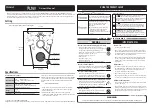
. When a synchronous machine is out-of-step, pole-slips occur. To recognize a
pole-slip, the complex impedance Z(R,X) must traverse the lens from right to left in case
of a generator and in the opposite direction in case of a motor. Another requirement is that
the travel across the lens takes no less than a specific minimum traverse time, typically
40...60 milliseconds. The above timing is used to discriminate a fault from an out-of-step
condition. In
, some important points on the trajectory of Z(R, X) are designated.
Point 0: the pre-fault, normal load Z(R, X). Point 1: impedance Z under a three-phase fault
with low fault resistance: Z lies practically on, or very near, the Z-line. Transition of the
measured Z from point 0 to point 1 takes app. 20 ms, due to Fourier filters. Point 2: Z
immediately after the fault has been cleared. Transition of the measured Z from point 1 to
point 2 takes approximately 20 ms, due to Fourier filters. The complex impedance then
travels in the direction from the right to the left, and exits the lens on the opposite side.
When the complex impedance exits the lens on the side opposite to its entrance, the 1st
pole-slip has already occurred and more pole-slips can be expected if the generator is not
disconnected.
shows two pole-slips. Figures like
always possible to draw by means of the analog output data from the pole-slip function,
and are of great help with eventual investigations of the performance of the out-of-step
function.
7.2.7.3
Maximum slip frequency
A pole-slip may be detected if it has a slip frequency lower than a maximum value
fsMax
.
The specific value of
fsMax
depends on the setting (parameter)
PickupAngle
(which
determines the width of the lens characteristic). A parameter in this calculation routine is
the value of the minimum traverse time,
traverseTimeMin
. The minimum traverse time is
the minimum time that the travel of the complex impedance Z(R, X) through the lens, from
one side to the other, must last in order to recognize that a pole-slip has occurred. The value
of the internal constant
traverseTimeMin
is a function of the set
PickupAngle
.For values of
PickupAngle
<= 110°,
traverseTimeMin
= 50 ms. For values
PickupAngle
> 110°,
traverseTimeMin
= 40 ms. The expression which relates the maximum slip frequency
fsMax
and the
traverseTimeMin
is as follows:
fsMax Hz
traverseTimeMin ms
PickupAngle
[ ]
≅
[ ]
⋅
°
[ ]
°
1000
1 000
180
.
-
[[ ]
ANSIEQUATION2319 V1 EN
(Equation 7)
The maximum slip frequency
fsMax
for
traverseTimeMin
= 50 ms is:
PickupAngle = 90° → fsMax = 20 × 0.500 = 10.000 Hz
PickupAngle = 100° → fsMax = 20 × 0.444 = 8.888 Hz
PickupAngle = 110° → fsMax = 20 × 0.388 = 7.777 Hz
(default 110°)
The maximum slip frequency
fsMax
for
traverseTimeMin
= 40 ms is:
Section 7
1MRK 511 365-UUS A
Impedance protection
164
Phasor measurement unit RES670 2.1 ANSI
Technical manual
Summary of Contents for Relion 670 Series RES670
Page 1: ...Relion 670 series Phasor measurement unit RES670 2 1 ANSI Technical manual ...
Page 2: ......
Page 36: ...30 ...
Page 76: ...70 ...
Page 106: ...100 ...
Page 150: ...144 ...
Page 274: ...268 ...
Page 326: ...320 ...
Page 356: ...350 ...
Page 382: ...376 ...
Page 416: ...410 ...
Page 590: ...584 ...
Page 604: ...598 ...
Page 694: ...688 ...
Page 756: ...750 ...
Page 834: ...828 ...
Page 836: ...830 ...
Page 876: ...870 ...
Page 886: ...880 ...
Page 887: ...881 ...
















































